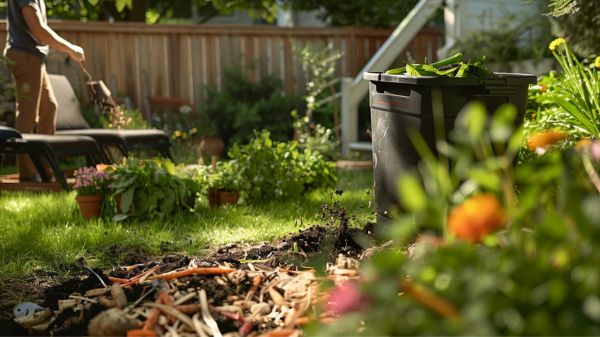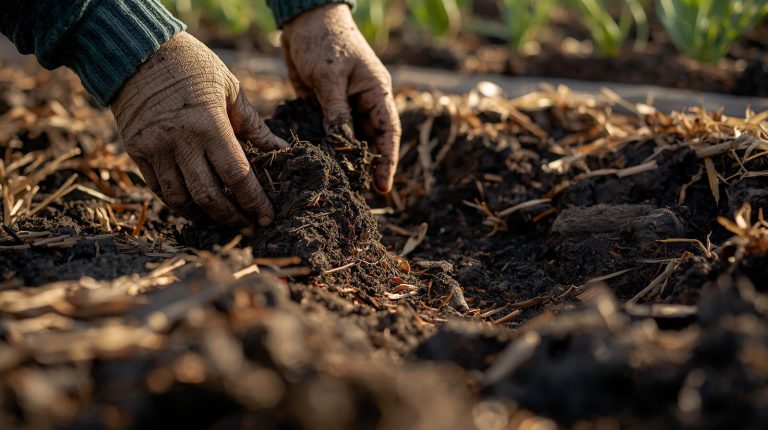Starting on the journey of home composting can be a rewarding experience, both for your garden and the environment. By following a few straightforward steps and making minor adjustments to your daily routine, you can transform kitchen scraps and yard waste into a valuable resource.
The process of composting not only reduces the amount of household waste sent to landfills but also enriches the soil in your garden. In the following discussion, we will explore the essential steps required to begin composting at home, enabling you to take a significant step towards sustainability and greener living.
Key Takeaways
- Choose suitable composting method based on space and preference.
- Set up compost bin in sunny area with good airflow.
- Collect green (food scraps) and brown (leaves) waste separately.
- Maintain proper moisture and aeration levels for decomposition.
- Turn compost pile regularly for efficient breakdown of materials.
Benefits of Home Composting
Home composting offers a myriad of benefits that not only reduce household waste but also positively impact the environment and promote sustainable gardening practices. Composting organic waste at home provides an efficient way to divert kitchen scraps and yard trimmings from landfills, reducing the environmental burden associated with waste disposal.
The nutrient-rich compost produced through home systems serves as an excellent soil amendment, aiding in improving soil health by enhancing its structure, moisture retention, and nutrient content. By using compost, gardeners can reduce their reliance on chemical fertilizers, thereby promoting a more sustainable and eco-friendly approach to gardening.
Furthermore, home composting plays an important role in environmental protection by helping to decrease greenhouse gas emissions.
The decomposition of organic matter in landfills produces methane, a potent greenhouse gas, whereas composting organic waste instead leads to the production of carbon dioxide, which has a lower impact on global warming.
Embracing home composting not only benefits individual gardeners but also contributes to broader efforts towards sustainability and environmental stewardship.
Choosing the Right Composting Method
Taking into account various factors such as available space, waste volume, and time commitment is crucial when choosing the most suitable composting method for your specific needs and circumstances. When delving into composting at home, there are several options to ponder:
- Aerobic Composting: This method involves utilizing oxygen to break down organic matter efficiently. It necessitates regular turning of the compost pile to aerate it and accelerate decomposition.
- Vermicomposting Methods: Employing worms to compost kitchen scraps and other organic materials can be a great option for those with limited space. Worm bins are compact and can be kept indoors.
- Anaerobic Cold Composting: Perfect for beginners or those with minimal space, this method entails allowing organic matter to decompose naturally without the need for turning or aeration.
For individuals with space constraints, exploring smaller composting methods like vermicomposting or anaerobic cold composting can be practical solutions. Moreover, alternative composting options provided by municipal programs, local farmers markets, or trash removal services can be considered for those seeking convenient alternatives to traditional composting setups.
Setting up Your Compost Bin
When setting up your compost bin, it is important to choose an appropriate location that receives adequate sunlight for decomposition and has proper drainage to prevent waterlogging.
Additionally, ensuring proper ventilation by selecting the right bin type and layering materials correctly can promote the breakdown of organic matter efficiently.
These initial steps are essential for creating a successful composting system at home.
Bin Location
Selecting a suitable location for your compost bin is crucial in guaranteeing efficient decomposition and effective maintenance of the compost pile. When deciding on the placement of your compost bin, consider the following:
- Near a water source: Choose a dry spot near a water source for easy access and to maintain proper moisture levels.
- Sunny location with good drainage: Opt for a sunny area with good drainage to aid decomposition and prevent waterlogging.
- Convenient and accessible: Position the compost bin in a convenient location for easy access and regular maintenance to secure successful composting.
Proper Ventilation
To guarantee the best breakdown of organic materials and promote efficient composting, proper ventilation is essential when setting up your compost bin.
Adequate airflow is vital to prevent foul odors and encourage the growth of beneficial bacteria in the compost pile. Ventilation holes or slots in the bin allow oxygen to enter and carbon dioxide to escape, facilitating the aerobic decomposition process.
Without proper ventilation, the compost pile may become anaerobic, resulting in unpleasant smells and slower decomposition rates. Ensuring your compost bin has sufficient ventilation creates ideal conditions for turning organic matter into nutrient-rich compost.
| Ventilation | Benefits |
|---|---|
| Adequate airflow | Prevents foul odors |
| Ventilation holes | Promotes beneficial bacteria |
| Oxygen intake | Facilitates aerobic decomposition |
Layering Materials
Layering materials in your compost bin is a fundamental step in creating a balanced environment for efficient decomposition and nutrient-rich compost production. To effectively layer your compost pile, follow these guidelines:
- Start with a base of twigs or mulch to aid in drainage and airflow.
- Alternate layers of green materials (fruit/veggie scraps, coffee grounds) and brown materials (dry leaves, paper) for a balanced mix of organic matter.
- Maintain proper moisture levels by adding water after each layer and finish with a top layer of soil or finished compost to kickstart the decomposition process.
Proper aeration by turning or aerating the compost pile regularly will help in achieving a successful decomposition process.
Collecting Green and Brown Waste
When starting composting at home, it is vital to efficiently collect green and brown waste to create a balanced and nutrient-rich environment for decomposition.
Green waste, such as fruit and vegetable scraps, coffee grounds, and grass clippings, is rich in nitrogen, providing essential nutrients for the microorganisms responsible for breaking down the organic matter.
On the other hand, brown waste, including dry leaves, straw, cardboard, and sawdust, is high in carbon content, aiding in maintaining airflow within the compost pile.
To guarantee effective composting, it is essential to collect green and brown waste separately. By storing them in designated containers, you can easily layer them in your compost bin.
The balanced mix of green and brown waste creates ideal conditions for decomposition, allowing the microorganisms to thrive and break down the materials efficiently. This method not only accelerates the composting process but also helps in producing nutrient-rich compost for your garden.
Maintaining Moisture and Aeration Levels
Maintaining ideal moisture and aeration levels within the compost pile is crucial for facilitating microbial activity and ensuring efficient decomposition processes.
- Monitor Moisture Levels: Keep the moisture content between 40-60% to support microbial growth and activity. Inadequate moisture can slow down decomposition, while excess moisture can lead to odor issues and nutrient loss.
- Ensure Proper Aeration: Regularly turn the compost pile to maintain aerobic conditions and prevent the formation of harmful gases. Aeration allows oxygen to reach microorganisms, promoting effective decomposition.
- Create Nutrient-Rich Compost: By monitoring moisture and aeration levels, you can produce high-quality compost rich in nutrients for your garden. Proper decomposition is dependent on the balance between moisture and aeration, so consistent monitoring is key to achieving excellent results.
Turning the Compost Pile Regularly
Regularly turning your compost pile is essential for maintaining ideal conditions for decomposition. By aerating the materials, you facilitate the work of beneficial microorganisms and prevent compaction.
Understanding the frequency of turning and utilizing the right tools can make this task more manageable and effective in producing nutrient-rich compost for your home garden.
Importance of Turning
Ensuring proper aeration through regular turning of the compost pile is essential for facilitating the decomposition process and promoting the transformation of organic matter into nutrient-rich compost.
When you turn the compost pile:
- Aerated materials provide oxygen to microorganisms, aiding decomposition.
- Prevents compaction and encourages breakdown of organic matter.
- Distributes moisture evenly, creating ideal conditions for decomposition.
Frequency for Best Results
For ideal decomposition and nutrient-rich compost production, adhering to a consistent schedule of turning the compost pile is key to achieving successful results. It is recommended to turn the compost pile every 2-3 weeks to help speed up the composting process.
Turning the pile regularly not only aids in aerating the materials but also guarantees proper distribution of moisture and nutrients, assisting in odor control and maintaining the right proportions of ingredients in the pile.
Additionally, consistent turning promotes microbial activity, which in turn accelerates composting and aids in breaking down materials effectively.
Adjust the frequency based on weather conditions, with more frequent turning necessary in hot, dry climates for successful results.
Tools for Easier Turning
To facilitate the process of turning the compost pile regularly and effectively, utilizing specialized tools such as a compost aerator can greatly enhance the efficiency of compost decomposition. When turning your compost, consider the following tools for easier and more effective results:
- Compost Aerator Tool: Specifically designed to penetrate and aerate the compost pile easily.
- Pitchfork or Compost Turning Tool: Helps mix the materials thoroughly, providing the necessary oxygen for decomposition.
- Compost Crank or Compost Turner: These tools aid in aerating the pile without requiring excessive physical effort.
Using these tools regularly guarantees ideal conditions for composting success, preventing odors, accelerating decomposition, and promoting even breakdown of materials.
Troubleshooting Common Composting Issues
When encountering common issues in composting, such as unpleasant odors or slow decomposition, proper management techniques can help address these challenges effectively.
To troubleshoot common composting issues, consider adjusting moisture levels, guaranteeing proper airflow, maintaining a balance of materials, and addressing mold growth. Here are some key solutions to tackle these problems:
| Common Issue | Possible Solutions |
|---|---|
| Unpleasant Odors | Adjust moisture levels, increase airflow, turn the pile |
| Slow Decomposition | Guarantee proper balance of green and brown materials, consider adding compost activator, chop materials into smaller pieces |
| Pests | Avoid adding meat, dairy, or oily foods to your compost |
| Mold Growth | Increase airflow, turn the pile to regulate moisture levels |
| Excessive Moisture Levels | Turn the pile for aeration, add dry materials to absorb excess moisture |
Utilizing Nutrient-Rich Compost in Your Garden
After troubleshooting common issues in composting, gardeners can maximize the benefits of nutrient-rich compost in their gardens by harnessing its soil-enriching properties and promoting sustainable gardening practices.
- Enhancing Soil Fertility: Incorporate compost piles made from a mix of organic materials, known as ‘greens’ (nitrogen-rich) and ‘browns’ (carbon-rich), to enrich the soil with essential nutrients like nitrogen, phosphorus, and potassium.
- Improving Soil Structure: Utilize compost as a natural soil conditioner to enhance soil structure, aiding in water retention and fostering beneficial microbial activity essential for plant growth.
- Promoting Sustainable Gardening: By integrating nutrient-rich compost into the soil, gardeners can reduce the reliance on chemical fertilizers, creating a healthier environment for plants while supporting eco-friendly gardening practices.
Frequently Asked Questions
What Is the Simplest Way to Start Composting?
The simplest way to start composting is through kitchen composting, utilizing a compost bin or pile. Indoor composting methods like worm composting or Bokashi composting are also effective. Urban composting can be achieved with a compost tumbler for efficient nutrient recycling.
What Are the 5 Easy Steps in Composting?
To begin composting, collect kitchen scraps and yard waste. Utilize a compost bin to contain the mixture of green and brown materials. Regularly turn the pile to facilitate decomposition by microorganisms. Eventually, this process yields nutrient-rich finished compost.
How Do You Make Compost at Home Step by Step?
Creating compost at home involves combining kitchen scraps and yard waste in a compost bin. Layer carbon sources like dry leaves with nitrogen sources such as vegetable peels. Regularly turn the pile, maintain proper moisture levels, and use aeration techniques to facilitate decomposition.
What Is the Simplest Composting Method?
The simplest composting method involves utilizing indoor or outdoor bins to collect a mixture of kitchen scraps, yard waste, and green materials. This process can also incorporate vermicomposting basics, utilizing composting containers or a compost pile for efficient organic waste breakdown.
Conclusion
To summarize, home composting offers numerous benefits such as reducing waste and providing nutrient-rich compost for gardens.
By choosing the right composting method, setting up a suitable compost bin, and properly maintaining moisture and aeration levels, you can easily start composting at home.
Regularly turning the compost pile and troubleshooting common issues will help guarantee successful decomposition.
Utilizing the resulting compost in your garden will not only improve soil health but also contribute to a more sustainable lifestyle.




